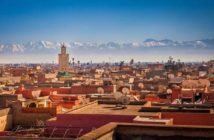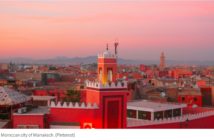Oye! Travel
Written by Ruth Kozak
My Moroccan trekking adventure began from the beautiful city of Marrakech near the foothills of the snow-capped High Atlas Mountains. I was with a group of trekkers from England: Ramblers Holidays.
The Ourika Valley
Our first trekking destination was the Ourika Valley in the foothills of the High Atlas Mountains. It was November, and the rainy season had begun in Morocco. The day before our trekking group arrived at the Ourika Valley, a flash flood had swept down the dry wadi, gouging away great chunks of the road and gnawing at the foundations of the mud-built Berber houses that perched dangerously above the river bank.
When we arrived at the starting point, we were forced to leave the van and walk to the meeting point as the roads were impassable. We teetered across foot-wide Berber bridges fashioned out of sticks, and suspended over the rushing, white water. We then squeezed behind houses on uneven, slippery pathways meant only for goats. In places where the road had washed away, the adjacent mud-brick houses hung precariously over the river bed .
The circular trip through the Ourika Valley took six hours; a total of just over seven kilometers. By the time we arrived back to where we had started, some of the road had been cleared. A van waited for us to take us back to the restaurant where our driver would be waiting. It was a ramshackle vehicle, the cabin gutted, with wooden benches along each side of the interior. Our group of fifteen trekkers and the tour leader crammed into the back. The driver, his companion and the Berber guides sat in the front and one other man stood on the back bumper. Amazingly, twenty people scrunched into a space that was meant for ten. In places, there was barely enough road left for the van to maneuver by. Miraculously we made it to the end of the road construction where our mini-van was waiting to take us back to Marrakech.
Crossing the Ourika River
Early the next morning, we set off for a visit to the Berber market in the town of Amizmiz. A Moroccan souq is a total sensory experience. We were greeted by a cacophony of sounds: goat bells, braying donkeys, merchants calling out their wares, shoppers haggling, and coppersmiths and blacksmiths hammering. The souq is comprised of very small shops and canopied stalls selling: fish, meat, poultry, locally grown fruit and vegetables, sacks of mint tea, nuts and dates. Spices such as saffron, cumin, ginger and cinnamon are displayed in colorful cone-shaped piles. The smells of mint, spices and baking foods fill the air with a mouth-watering fragrance. In one lane the barber shops were doing a brisk business. Men can get a shave and haircut while their wives bargain in the market. In another lane a man tends the barbecue coals under a dozen cone-shaped clay tajine pots containing chicken or lamb stewed with eggplant, carrots, onions and raisins in savory spices, to be served over steaming plates of couscous. Dinner’s ready when your shopping’s done!
One thing to remember, in Morocco people do not like to be photographed. So we devised a sneaky way of capturing some of these scenes by having our companions pose in such a way that we could ‘sneak’ photos of the local residents.
Leaving the Amizmiz souq, we headed up into the mountains on a well-maintained forestry road. Here the villages are different from those in the Ourika Valley. Tiered on the mountainside, their ochre clay walls almost make them invisible in the mountain landscape. There are well-irrigated terraced gardens and lemon and olive groves. The road is lined with eucalyptus trees and the mountain slopes are rocky and arid. The scent of lavender and thyme makes the air fragrant and the walk pleasant.
A Walk in the Asni/Ourigane Foothills
The next morning we set off for another trek to inspect a higher route along the ravine above the River Ourigane. We stopped to rest under some trees, and had lunch provided by the guides. My foot was sore after so much hiking, so instead of attempting the more difficult climb up into the mountains with the rest of the group, I opted to cross the valley on the Berber trails instead and was provided with my own personal guide, Mabourak.
The countryside is stunning with its shrub-covered knolls and rich sienna-red earth. Because my guide was well informed about the flora and fauna of the land, our walk became a geology and botany lesson. Minerals abound in the area and I collected agate, flint, hematite and bits of lapis lazuli. Mabourak showed me wild garlic, thyme and other herbs and wild flowers. Low bush juniper and quince grow in abundance. In the reforested juniper groves nearby, wild boar are hunted. Other animals such as fox, mountain sheep and goats, and jackals roam here as well. There are many wild birds too, such as eagles, hawks, cuckoos and pheasants. As we walked, my guide told me about his life, and his family on the Sahara. The trek with Mabourak, was the highlight of my Moroccan adventure. I was glad that I’d had that time alone to absorb the beauty of the countryside and to get acquainted with one of the locals.
Written by W. Ruth Kozak for EuropeUpClose.com














